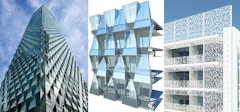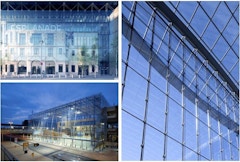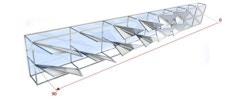
169 results
-
 The Lucile Packard Children’s Hospital at Stanford University in Palo Alto, California features an extremely diverse set of facade systems within one…
The Lucile Packard Children’s Hospital at Stanford University in Palo Alto, California features an extremely diverse set of facade systems within one… -

Thinking About Facades
- Paper by Marc Schiler, FASES, LC,
There have been three decades of liberating developments in the application of descriptive geometry and freeform design methods, as well as the… -

Adaptable Glazing Shields
- Paper by Anas Al Kassas
Today, about 40% of all buildings in the U.S. still have single-pane windows, and ~70% of the existing building stock is estimated to suffer from
-
Adaptive Facades
- Paper by Walter Haase · Werner Sobek · Enrica Oliva · Michele Andaloro
Facade engineering aims at appropriately balancing the demands imposed by the context and the capabilities inherent to the materials, the geometries
-

Designing with Photovoltaics
- Paper by Wayne Walker, Associate, Project Architect Julia Ragragio Ruiz, LEED AP BD+C, Sustainability Strategist Sam Crawford, Intern
Photovoltaics (PV) have been utilized in buildings for decades, especially in Europe where legislative support has largely driven the market. With… -
Interstitial condensation risk assessment
- Paper by Jelle Langmans · Piet Houthuys · Wout Parys · Staf Roels
The development of methods to predict and control moisture accumulation in building envelopes has always been a key element in building science.
-

Geometric Patterns as Architectural Forms
- Paper by Joshua Schultz, PhD, PE, LEED AP · Neil Katz, AIA
Facade design is a key component of architectural expression, and increasingly a key design consideration due to growing importance of factors like:
-
Exploring Interoperability between Rhino and Revit through Rhino.inside
- Paper by Vincent Ip
This paper presents a comprehensive interoperability workflow achieved between Rhino and Revit through Rhino-Inside. The study focuses on two case
-

Design Principles For Museum Daylight Systems
- Paper by Edgar Stach, PhD · Michael Esposito
This research unlocks the relationship between space, structure and light in nine unique museums developed by architect Renzo Piano. Renzo Piano uses
-

Parametric Facade Design
- Paper by Patricia E. Camporeale · María del Pilar Mercader Moyano
Parametric Design has become an invaluable tool for complex tasks like designing energy efficient buildings when joined to performance-based
-

Kinetic Solar Envelope
- Paper by Christina Koukelli, Facade Engineer Alejandro Prieto, Researcher Serdar Asut, Academic, Architect
Kinetic responsive systems are gaining attention in architectural applications, to reduce the building’s energy consumption and environmental impact,… -

Specifying Commercial Aluminum Finishes
- Paper by Ben Mitchell, MBA
Many factors will influence coating selection, but to achieve the desired performance level for a given situation, coatings must be specified based
-

Heat-actuated Auxetic Facades
- Paper by Amira Abdel-Rahman · Elnaz Tafrihi
Highly transformable materials can be used as adaptive exterior shading systems by leveraging the relationship between external stimuli (heat) and
-
Kinetic Shading Systems
- Paper by Alireza Jahanara · Negar Kalantar
This study focuses on experiments in kinetics and architectural skins. More extensively, it introduces a solution for environmental design issues and
-

Emulating Nature's Structured Randomness in Facade Design
- Paper by Ned S. Kirschbaum FAIA, CCCA, LEED AP BD+C,
The wonder of nature is the abundance of unique forms she creates based on a few simple physical principles or laws. No two snowflakes are alike.… -

Coupling Facade and Structure
- Paper by Trevor Stephen Lewis, PhD, PE · Jessica Chen, PE
Traditional approach for engineering the facade is building an isolated analysis model. However, it inhibits a dynamic design process where
-

Performance Based Generative Facade Workflow for Large Scale Projects
- Paper by Paul Ferrer · Mili Kyropoulou · Tim Logan · Heath May · James Warton
Over the last two decades, in what has been coined “The Digital Turn”, the introduction of parametric design software has afforded increased
-
BioFacades Classification
- Paper by Mary Ben Bonham, Kyoung Hee Kim, Professor, Director of IDRL | Founder of EcoClosure Christiane M. Herr, Professor at the School of Design, Southern University of Science and Technology, Shenzhen
Coauthors: Mary Ben Bonham, Department of Architecture + Interior Design, Miami University, Oxford, OH, USA [corresponding] [presenting at the… -
North Capitol Building Case Study
- Paper by Jeremy Simmonds, Project Manager at KEPCO+ Bruce Knaphus, President
The Utah State Capitol North Building, currently under construction, features 80,000 SF of classically designed cubic granite detailing, including… -

Historical Evolution of Responsive Facades
- Paper by Negar Heidari Matin, Ph.D. Candidate, LEED GA, Ali Eydgahi, Ph.D., Shimming Shyu, Ph.D., RA, LEED AP BD+C, Payam H. Matin, Ph.D.,
Responsive facade system is considered a major component of high-performance building envelope that is capable of responding to environmental stimuli…

